

- Survey: Nearly half of schools to move to BYOT in near future. 0 Comments September 7, 2012 By: Sep 7 Written by: 9/7/2012 1:33 PM ShareThis A recent survey conducted by MDR’s EdNET Insight research services for Mimio, polled more than 150 educational professionals, including school district technology, instructional media services, and curriculum directors, coordinators and specialists.
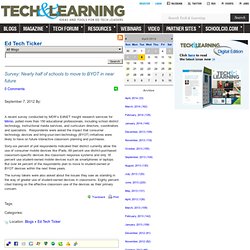
Sixty-six percent of poll respondents indicated their district currently allow the use of consumer mobile devices like iPads, 69 percent use district-purchased classroom-specific devices like classroom response systems and only 18 percent use student-owned mobile devices such as smartphones or laptops. The survey takers were also asked about the issues they saw as standing in the way of greater use of student-owned devices in classrooms. Special Section How It’s Done: 20 Ways to Make Tech Work in Schools. 1/12/2012 By: James Careless The latest controversy in the education press has once again become a handwringing, brow-furrowing discussion on whether or not technology “works” in the classroom.
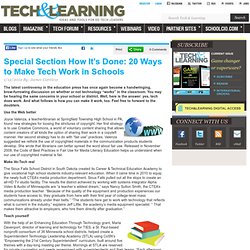
You may be hearing the same concerns in your school or district. Well, here is the answer: yes, tech does work. And what follows is how you can make it work, too. Feel free to forward to the doubters. Use the Web better Joyce Valenza, a teacherlibrarian at Springfield Township High School in PA, found new strategies for loosing the strictures of copyright. Texting 1, 2, 3: Schools Test ‘Bring Your Own Technology’ Programs.
As protesters took to the streets yesterday to protest the inequality of wealth, two computer scientists in Portland, Oregon are protesting the inequality of resources in schools.
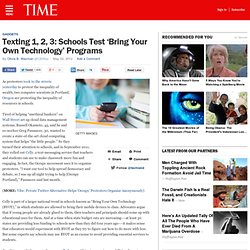
Tired of helping “unethical bankers” on Wall Street set up cloud data management systems, Russell Okamoto, 45, said he and co-worker Greg Passmore, 30, wanted to create a state-of-the-art cloud computing system that helps “the little people.” So they turned their attention to schools, and in September 2011, they rolled out Celly, a text-messaging service that teachers and students can use to make classwork more fun and engaging. In fact, the Occupy movement uses it to organize protesters. Creating a Robust and Safe BYOD Program. Until recently, student electronic devices, from cell phones to iPods to laptop computers, were the forbidden fruit in schools.

But with technology budgets languishing and such devices becoming more powerful, affordable and omnipresent in students’ lives, district technology leaders are now eyeing a welcome educational harvest through bring-your-own-device (BYOD) programs. Lucy Gray, project director of the Leadership for Mobile Learning Initiative at the Consortium for School Networking (CoSN), has studied early BYOD adopters. “I’m stunned by the number of school districts opening their minds to this approach,” she says. Mobile Learning with Bring Your Own Devices. Moving Schools Forward With BYOD. The following is a guest blog post by Dr.
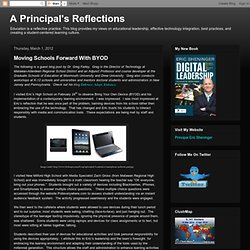
Greg Farley. Greg is the Director of Technology at Matawan-Aberdeen Regional School District and an Adjunct Professor and course developer at the Graduate Schools of Education at Monmouth University and Drew University. Bring Your Own Technology Empowers Educators to Facilitate Learning. Round Rock school tells students: BYOD, bring your own devices. At Walsh Middle School, the sight of students focused on the glow of smartphone LED screens and the click-clack of keyboards could become common place.

Walsh asked eighth-graders to bring in gadgets from home Thursday for Bring Your Own Device Day, a collaboration between Dell Inc. and the Round Rock school district to bring technology into classrooms to help students in their studies. Having students use devices they already own — and are already familiar using — allows the district to save on the expense of buying computers for students. Dell has agreed to help teachers integrate various home-brought devices into lessons.
Devices can be anything, from a smartphone to a tablet to a laptop. Don’t be scared of “Bring Your Own Device” Working in technology administration, I have always bowed down to uniformity.

I can’t help it…it’s the way we were all taught in the technology industry. It was routine and comfortable. Everyone got the exact same computer with the same image. How would I prepare to teach a BYOD class? I've been thinking and reading about what it would be like to teach a (math) class in a school with a Bring Your Own Device policy.
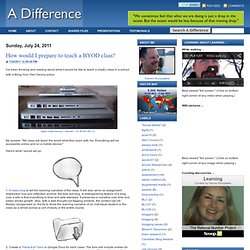
My answer: "My class will teach the world what they learn with me. Everything will be accessible online and on a mobile device. " Here's what I would set up: 1. A class blog to tell the learning narrative of the class. 2. 3. 4. 5. 6. What Do Kids Say Is The Biggest Obstacle To Technology At School? iPads.
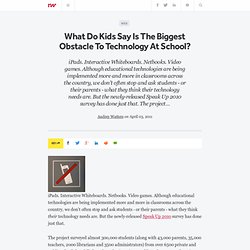
Interactive Whiteboards. Netbooks. Video games. Although educational technologies are being implemented more and more in classrooms across the country, we don't often stop and ask students - or their parents - what they think their technology needs are. But the newly-released Speak Up 2010 survey has done just that. The project surveyed almost 300,000 students (along with 43,000 parents, 35,000 teachers, 2000 librarians and 3500 administrators) from over 6500 private and public schools last fall about how they're using - and how they want to be using - technology for learning.
The results are pretty fascinating, as they show great adoption of technology among even very young students, but lingering resistance on the part of school administrators to sanction some of those tools into the classroom. Bring-your-own-device projects cut costs.